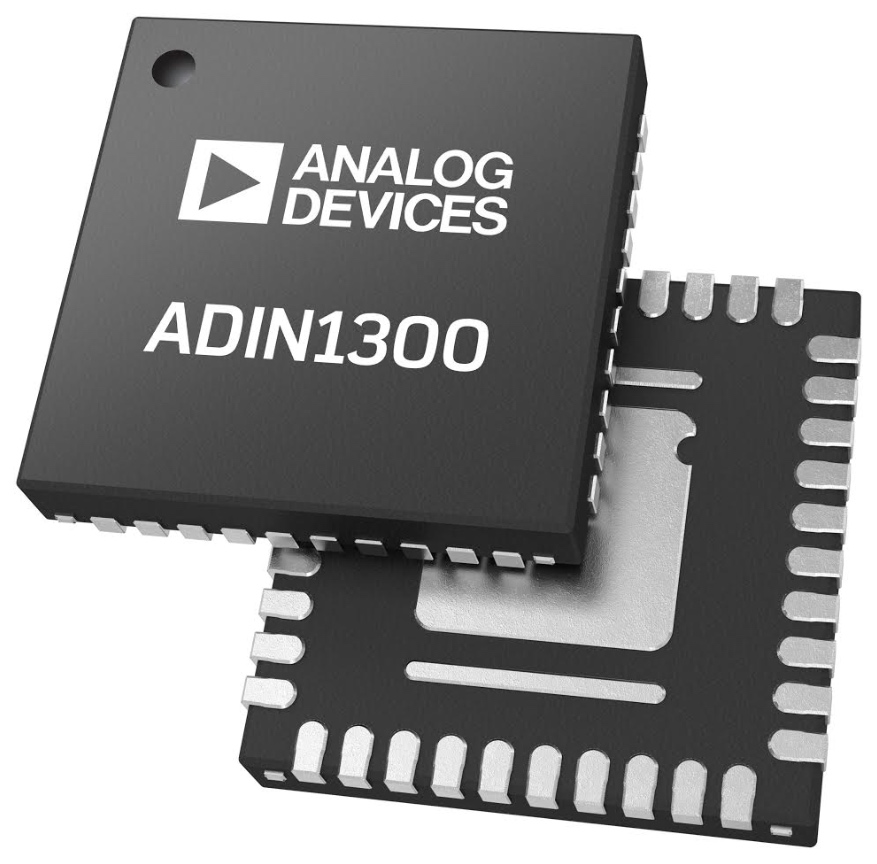Analog Devices Reveals a Low-power PHY Chip for the Industrial Ethernet
The ADIN1300 is a low-latency, single-port Ethernet transceiver for gigabit-speed operation in harsh environments.
Analog Devices' new industrial Ethernet physical layer products are designed to meet the communication challenges presented by Industry 4.0 and the smart factory. Modern industrial automation is fast adapting Ethernet-based solutions to comply with the low-latency requirements of time-critical operations.
To meet these needs, ADI has introduced the latest member of its ADI Chronous Ethernet family, the ADIN1300 and the ADIN1200.

ADIN1300 PHY chip. Image from Analog Devices
The ADIN1300 PHY chip is a single-port, Gigabit Ethernet transceiver that, according to Brendan O’Dowd of Analog Devices, "ensures real-time, robust industrial communications by targeting important challenges of deploying industrial Ethernet connectivity with low latency in a smaller package size to reduce industrial Ethernet network cycle times."
O'Dowd also expressed that the "updated suite of ADI Chronous Ethernet solutions [represents] a new standard for industrial Ethernet speed, scalability, and range of multi-protocol support, all backed by ADI’s commitment to long life cycle product availability and support.”
What are PHY Devices and the PHY Layer?
The International Standards Organization (ISO) has defined the Open System Interconnection (OSI) Model, which is a framework under which digital devices communicate to each over a network. There are seven layers to this framework with layer one being the physical (PHY) layer.
The PHY layer consists of the actual electronic circuitry used to send and receive the raw digital ones and zeros over the network. The PHY layer can be implemented most simply and easily by a PHY chip.
Applications
O'Dowd claims that “Within industrial environments, even one millisecond of communications timing being off can produce a negative, expensive impact on quality, throughput, and efficiency for manufacturers.”

The ADIN1300 is designed to improve communication standards in smart factories. Image (modified) used courtesy of Analog Devices
As such, both devices are designed for robust applications in industrial, building, and factory automation. Analog Devices also sees ADIN1200 and ADIN1300 being useful for robotics control, motion control, and process control as well as for test and measurement and industrial IoT.
Specifications
One major standout difference between the ADIN1200 and the ADIN1300 is that the ADIN1200 is 10BASE-T/100BASE-TX IEEE 802.3 compliant while the ADIN1300 is 10BASE-Te/100BASE-TX/1000BASE-T IEEE 802.3 compliant.

Functional block diagram of ADIN1300. Image from Analog Devices
Latency
ADIN1300
1000BASE-T RGMII latency transmit < 68 ns, receive < 226 ns
100BASE-TX MII latency transmit < 52 ns, receive < 248 ns
ADIN1200
100BASE-TX RGMII latency transmit < 124 ns, receive < 250 ns
100BASE-TX MII latency transmit < 52 ns, receive < 248 ns
Power Consumption
ADIN1300
330 mW for 1000BASE-T
140 mW for 100BASE-TX
ADIN1200
139 mW for 100BASE-TX
Packaging
ADIN1300
The ADIN 1300 is available in a 40-lead, 6 mm × 6 mm LFCSP.
ADIN1200
The ADIN 1200 is available in a 32-lead, 5 mm × 5 mm LFCSP.
Both devices are specified for −40°C to +105°C ambient operation.
Getting to Market Faster
ADI offers the EVAL-ADIN1300, an evaluation board to enable designers to become more familiar with the ADIN1300. The unit comes complete with a Management Data Input/Output (MDIO) interface dongle boards.

The evaluation board for ADIN 1300. Image from Analog Devices
Analog Devices will be exhibiting its Chronous Ethernet portfolio solutions, including the ADIN1300 at SPS, November 26–28, 2019, in Nuremberg, Germany.
Around the Industry
The ADIN1200 and ADIN1300 compare to several other counterparts around the industry.
Microchip’s KSZ9031 is a 10/100/1000Mbps IEEE 802.3 compliant Ethernet transceiver. Versions of the device are available with AEC-Q100 qualifications.
The DP83867CR from Texas Instruments supports 10BASE-Te, 100BASE-TX and 1000BASE-T Ethernet protocols. The unit is optimized for ESD protection, exceeding 8-kV IEC 61000-4-2 (direct contact).
Do you work with industrial Ethernet physical layer products? Share your experiences in the comments below.







